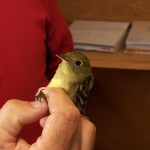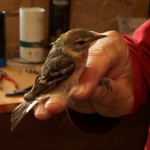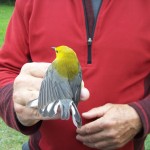I think it was the great Canadian singer/songwriter Neil Young that used the phrase “rust never sleeps”. And neither do SAR’s (Species At Risk). However, Christine, Ruthven’s SAR co-ordinator sleeps and so, consequently, missed an awsome SAR and a new bird for Ruthven banding station. A Prothonotary Warbler. Now, Brian likes to sleep but since he was on duty today he couldn’t and it payed off for him big time. Doing an early net round he came upon the bird in Net #10, which is down in the stream valley and brought it up to the lab for everyone to see. There was one older birder there who walked in a bit later. I asked him if he had ever seen a Prothonotary Warbler and when he said ‘no’ I was able to amaze him by pulling it out of the bag right in front of him. Great fun.
It was a good day all round: lots of interesting birds and lots of interesting people who were very interested in the birds and in the Ruthven site. It was sort of like preaching to the choir all morning long. There was quite a varied mix of warblers on the grounds – 18 species: Northern Parula, Prothonotary Warbler, Brewster’s Warbler, Blue-winged Warbler, Nashville Warbler, Yellow Warbler, Magnolia Warbler, Cape May Warbler, Yellow-rumped Warbler, Black-throated Green Warbler, Blackburnian Warbler, Western Palm Warbler, Bay-breasted Warbler, Blackpoll Warbler, American Redstart, Ovenbird, Common Yellowthroat, and Canada Warbler.
This fine selection was likely made possible by the very unsettled weather, There was a thunderstorm with some heavy but brief rains in the very early morning which likely resulted in a ‘drop’ of migrants during the night (i.e., they were forced to stop migrating by the storm and come to earth). And for much of the morning there wasn’t that much wind so they were easy to find (that is the ones that didn’t find their way into the nets). [Later, around noon, the wind pickied up to Force 6 during some gusts.]
We had some firsts for the year: Yellow-bellied Flycatcher, Swainson’s Thrush, Bay-breasted Warbler, Blackpoll Warbler, Canada Warbler and, of course, the Prothonotary.
We also had some notable retraps – the best being a Yellow Warbler that originally had been banded as an adult bird in July 2000 making it at least 10 years old!!! Think about how many miles it has logged between Ruthven and Mexico during this time!!
Banded 53:
1 Mourning Dove
1 Yellow-bellied Flycatcher
1 White-breasted Nuthatch
2 House Wrens
1 Blue-gray Gnatcatcher
1 Swainson’s Thrush
7 Gray Catbirds
1 Nashville Warbler
6 Yellow Warblers
3 Magnolia Warblers
1 Yellow-rumped Warbler
2 Western Palm Warblers
1 Prothonotary Warbler
1 Bay-breasted Warbler
1 Ovenbird
3 Common Yellowthroats
4 American Redstarts
2 Canada Warblers
4 Rose-breasted Grosbeaks
1 Indigo Bunting
1 Chipping Sparrow
1 Eastern White-crowned Sparrow
4 Baltimore Orioles
3 American Goldfinches
Retrapped 28:
1 Blue Jay (2004)
1 Black-capped Chickadee
1 House Wren
1 Gray Catbird (not banded at Ruthven)
5 Yellow Warbler (one banded in 2000)
1 Northern Cardinal
2 Rose-breasted Grosbeaks
2 Chipping Sparrows
3 Song Sparrows
1 Red-winged Blackbird
3 Brown-headed Cowbirds
1 Common Grackle (2006)
6 Baltimore Orioles (one in 2005; one in 2004)
ET’s: 66 spp (highest so far this year)
Rick
A few photos from the day, contributed by a visitor. In the photos are the Prothonotary Warbler, A Yellow-bellied Flycatcher, and a Bay-breasted Warbler.





